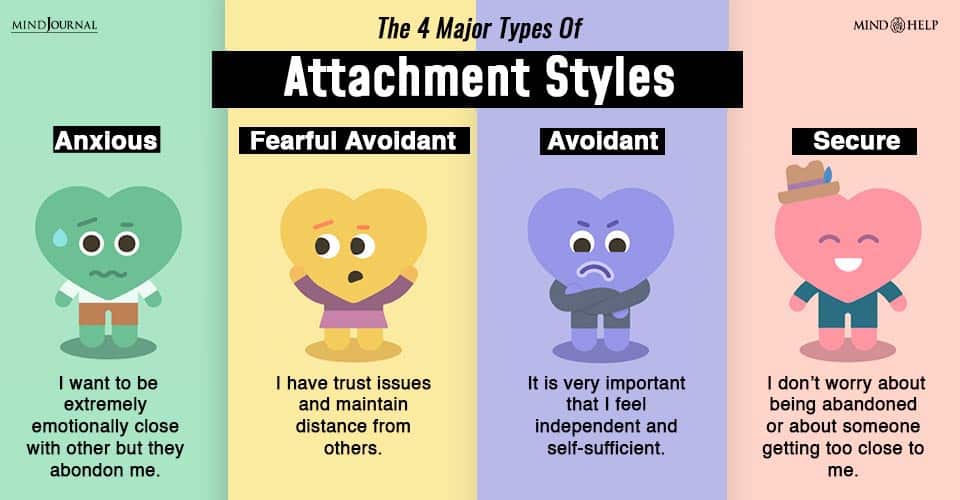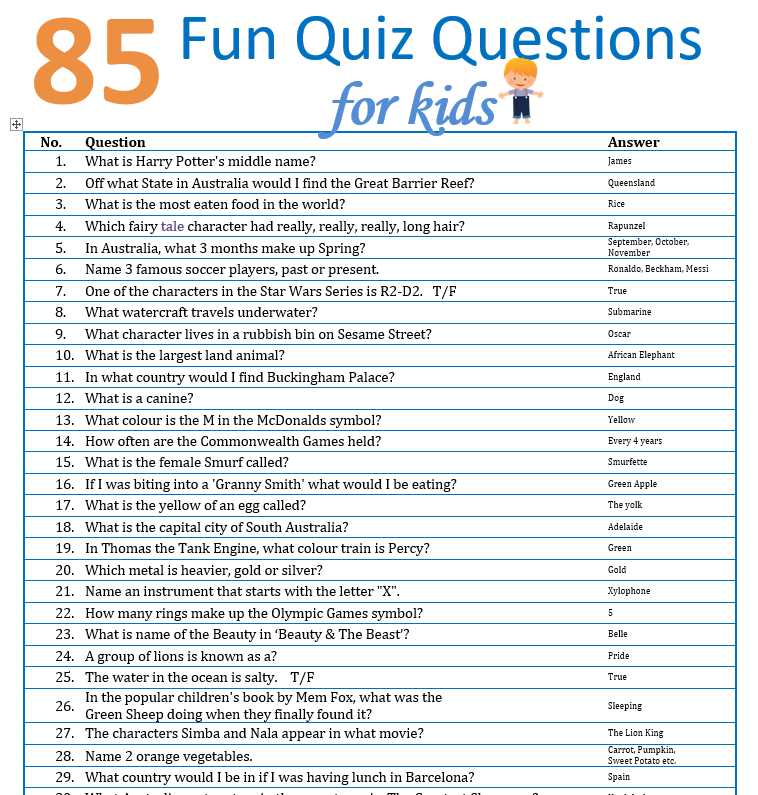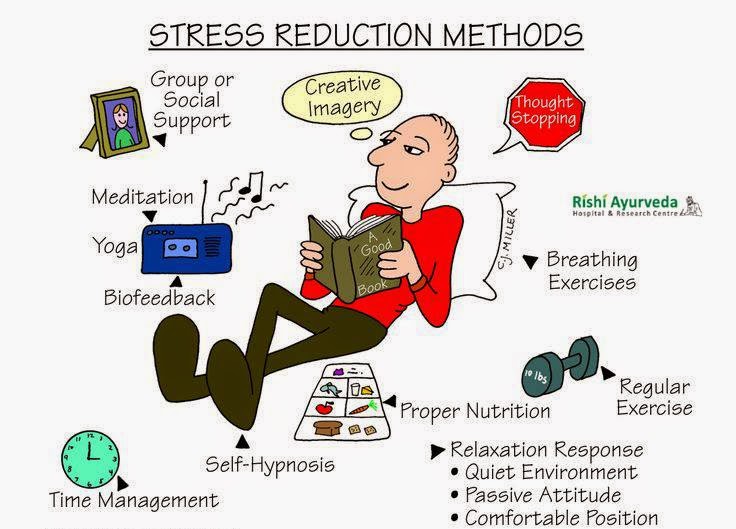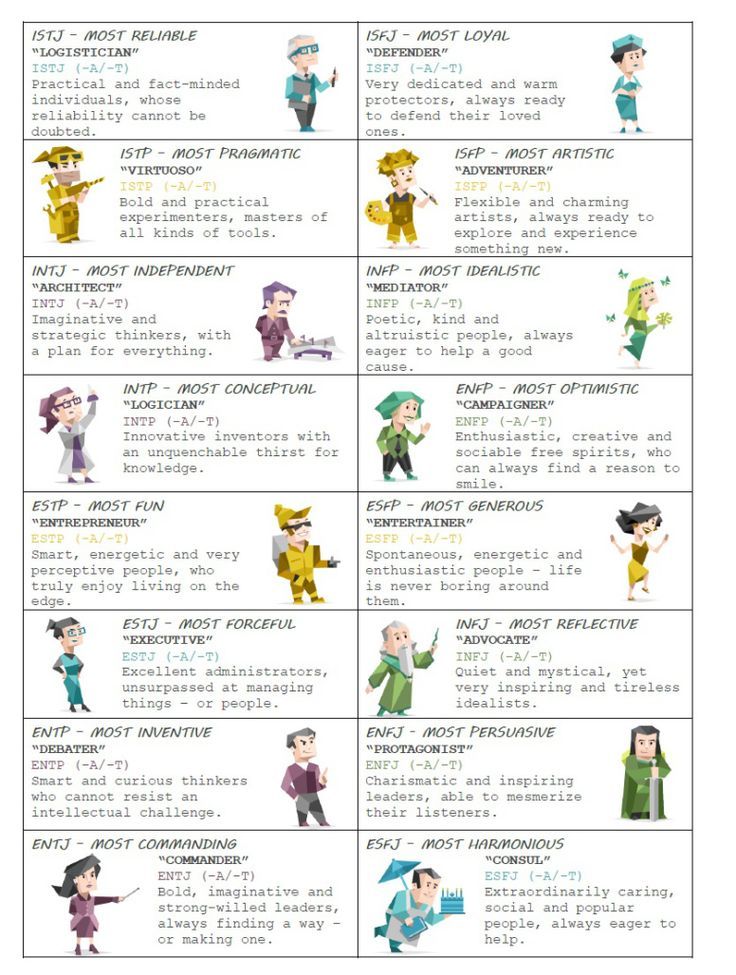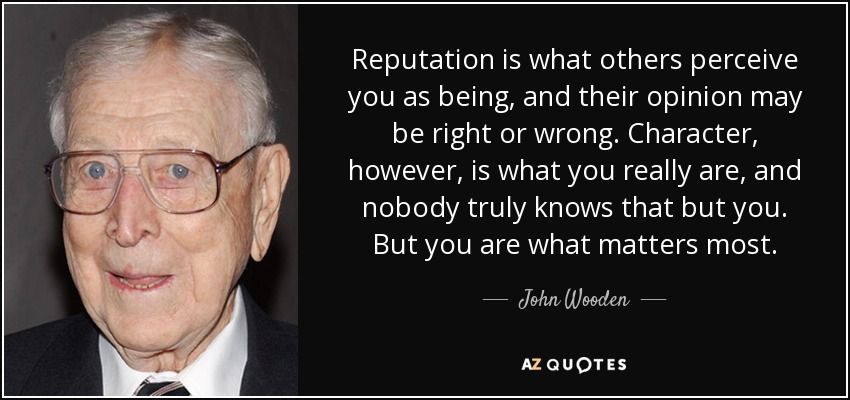Healing anxious attachment style
5 Steps To Become More Secure
Do you feel that uncontrollable worrying about your romantic relationships consumes far too much of your mental space? If so, you’re in the right place. Today we’ll unpack healing anxious attachment style. We’ll find out how to heal for a more peaceful, grounded attitude towards love, life and loss.
Table of Contents
What is an anxious attachment style?Bowlby’s attachment theoryIn the 1950’s, psychiatrist John Bowlby carried out what was to become some very famous research upon mothers and their babies. He first observed the behavior of young children in the presence of their mother. He then observed them when she left the room for a while, and again on her return.
Bowlby linked the children’s attachment styles to their distress levels when their mother had gone, and also to their reactions when the mother returned.
The attachment styles of the children were found to depend on the parenting style of the mother. Children with an attentive, responsive mother tended to have a secure attachment style. Those with a disconnected, unresponsive mother were more avoidant. Children with an attentive, responsive yet inconsistent mother (such as one who worked a great deal) were anxiously attached.
Hence, if a child’s needs were not consistently and adequately responded to, they would develop attachment issues, in the form of an insecure attachment style.
The work of Levine and Heller: attachment styles in relationshipsMore recently, Amir Levine and Rachel Heller published an internationally best-selling book, ‘Attached’. This book took the world by storm and is truly a must-have for anyone living with an attachment wound. I have quoted it many times in my articles – and for good reason.
In the book, Levine and Heller explain in great detail the impact of growing up as an adult with an insecure attachment style. They focus on the interplay of differing attachment styles in a romantic relationship.
The insecure-avoidant partner is profiled as having the following characteristics:
- Fear of intimacy, resulting in hot and cold behavior when they perceive their partner as having come too close
- Cold, detached, and requiring a great deal of personal space
- Firm with boundaries
- A deep, often subconscious feeling of inadequacy
- Good at meeting their own needs instead of relying upon others. Also known as ‘self-soothing’
The insecure anxious partner on the other hand, is described as having quite different characteristics:
- A deep, almost insatiable craving for intimacy
- Persistent fear of rejection or of losing their partner. If they have ever been broken up with, they are haunted by the possibility of this happening again
- Obsessive thinking about their partner
- Worrying a great deal about losing the relationship
- A need for a great deal of contact and time spent together
- Weak ability to meet their own needs (self-soothe), and a tendency to rely upon others to do this for them
- Weak sense of self-identity
Inside of a relationship, an anxious/avoidant couple can run into a great deal of problems.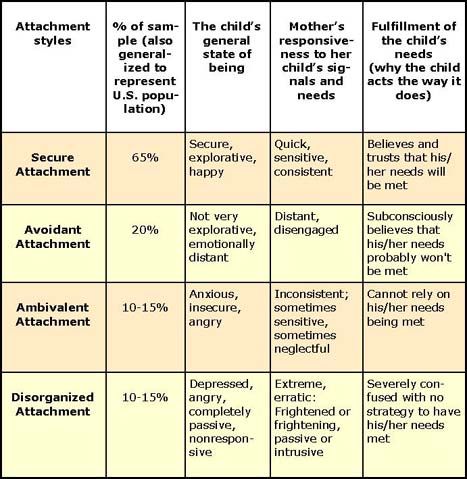
The anxious partner constantly feels rejected. This confirms their subconscious belief that they are not good enough, and will be abandoned. Both partners fail to understand the other. They don’t understand how to meet each others’ needs or respond to emotional situations. Conflict is frequent. Both partners often feel misunderstood, judged and criticized.
The avoidant (AKA dismissive avoidant) partner feels smothered. This confirms their belief that romantic relationships mean losing independence, and are not to be trusted. They feel frustrated with the anxious partner, not understanding why they need so much attention. Men with mommy issues tend to develop this attachment style. When they grow up to have a dysfunctional relationship with their mother, they usually end up with a fear of intimacy, at least to some degree.
It is important to note that mommy issues in women also exist. But for whatever reason, they seem to be less common than in males.
Crucially, the book points out the that anxious and avoidant partners tend to be drawn to each other like magnets.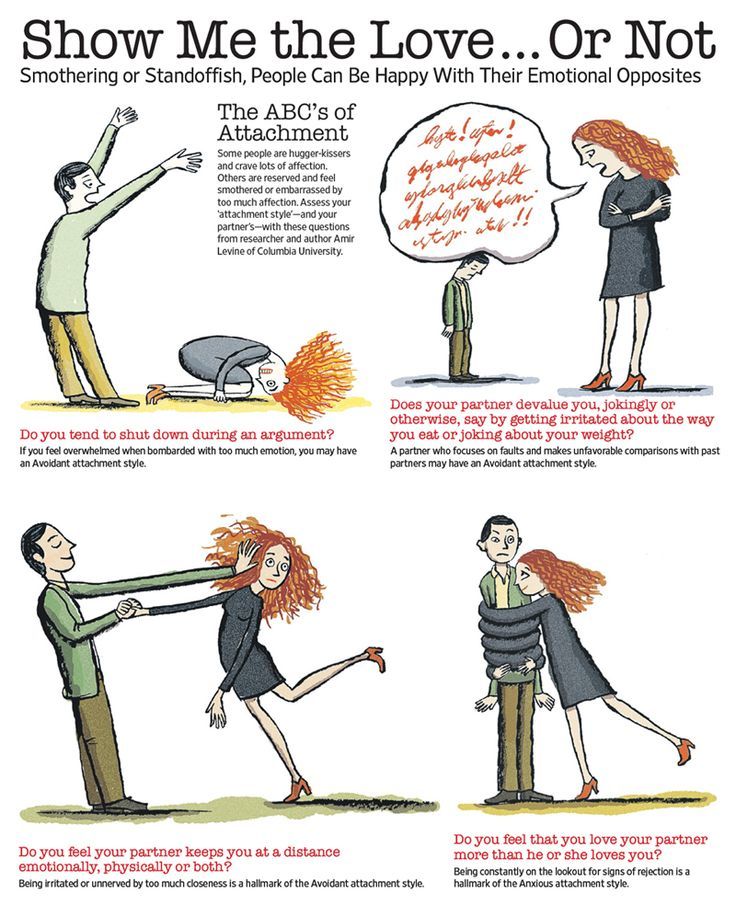
In her book ‘The Power of Attachment’, Diane Pool Heller expands on this. As she puts it, our choice of partner is a way for the subconscious mind to confirm its beliefs about the world. An anxious person would likely be repulsed by another anxious person, since their subconscious mind is seeking confirmation from their partner that they are unworthy of love. Two avoidants meanwhile, would probably never be able to establish enough intimacy to create a romantic bond.
Hence anxious and avoidant partners are drawn to one another like moth to flame. And unfortunately this unfortunate coupling can lead to a great deal of pain and suffering for both individuals.
This suffering is due to the radical contrast between the needs and desires of the anxious and the avoidant partner. Despite a fundamental incompatibility, these relationships can be incredibly hard to break free from. The relationship feels familiar and safe, despite the fact that it might be deeply painful and turbulent. The relationship itself is confirming both individuals’ subconscious beliefs about themselves and others. Hence, the attraction is strong.
The relationship itself is confirming both individuals’ subconscious beliefs about themselves and others. Hence, the attraction is strong.
The anxious/avoidant relationship is particularly hard for the anxious partner. Because they tend to be more sensitive and highly attuned to others, their mental health can really take a hit. Relationship anxiety is their modus operandi. And sometimes they can end up with full-blown anxiety disorder.
WATCH FREE TRAINING NOW
Boost your confidence, master your sexuality, and find your purpose.
So you can reignite the passion in your relationship or attract your perfect woman.
Being an anxiously attached partner can really suck. Especially if you are dating an avoidant. If this article on healing anxious attachment goes down well, I’ll write another on healing avoidant attachment.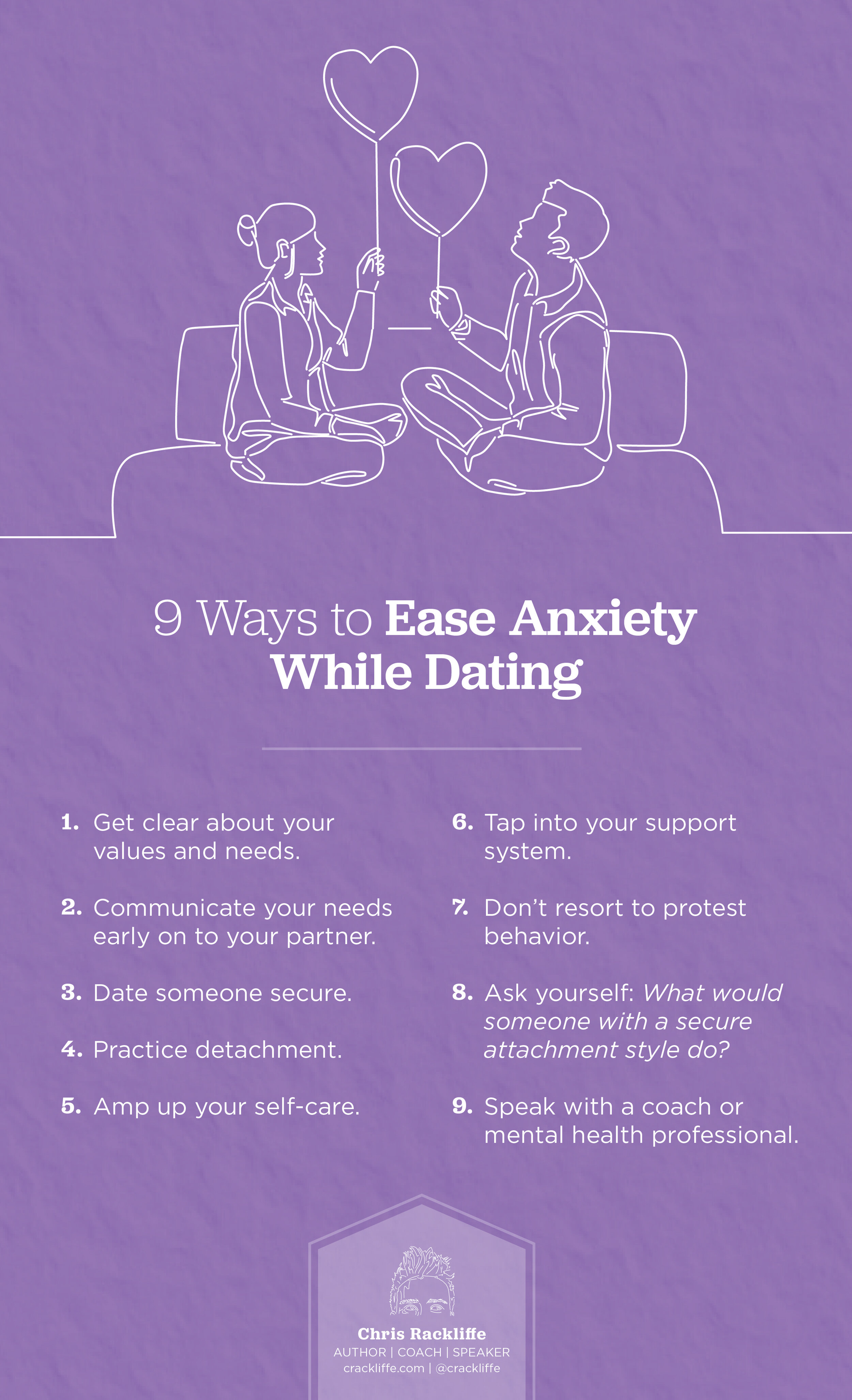
It is not uncommon to feel that the ground beneath your feet is constantly shaking. Everything you love and cherish could be ripped away from you in an instant. The fear of losing your intimate relationship quite literally haunts you.
Due to being a naturally more sensitive, people-oriented person, you are highly attuned to words, body language and behavior of others. Particularly that of your partner. This can lead to over-analysis, and foreseeing problems that do not and will not exist.
Perhaps your partner took three hours to respond to your text when they usually write back straight away. In reality, they may have been in an important business meeting, or driving. But in your head, they were cheating on you, or were losing interest.
In response to this over-analysis and constant worry, the anxiously attached person can resort to unhealthy behavior. This can include texting or calling many times in a row, or showing up at their partner’s house without warning.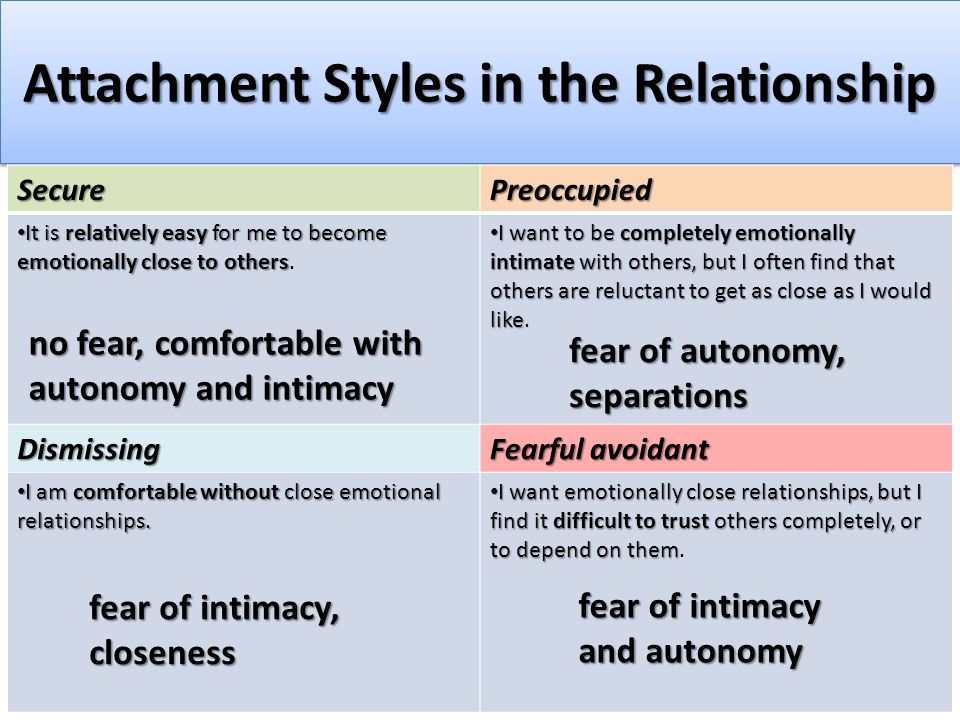 This is pretty unattractive behavior for anyone. But particularly if they are dating an avoidant, it can have disastrous consequences.
This is pretty unattractive behavior for anyone. But particularly if they are dating an avoidant, it can have disastrous consequences.
In their lifelong quest to find, maintain and protect their intimate relationship at all costs, they often end up pushing it away.
This is why healing anxious attachment is so important in order to have a happy, less stressful life.
Living with an anxious attachment styleWhen you are the anxiously attached personThe anxiously attached person typically has a weak sense of identity, and huge abandonment issues. They have problems meeting their own needs and an over-reliance on others.
Anxiously attached people often live with the following problems:
- Poor mental health: intense attachment insecurity means that they are plagued by thoughts about their relationship. This can impact their ability to enjoy other things in life such as friendships and hobbies
- Hyperstimulated nervous system: the nervous system of a person with an anxious attachment style is often overstimulated.
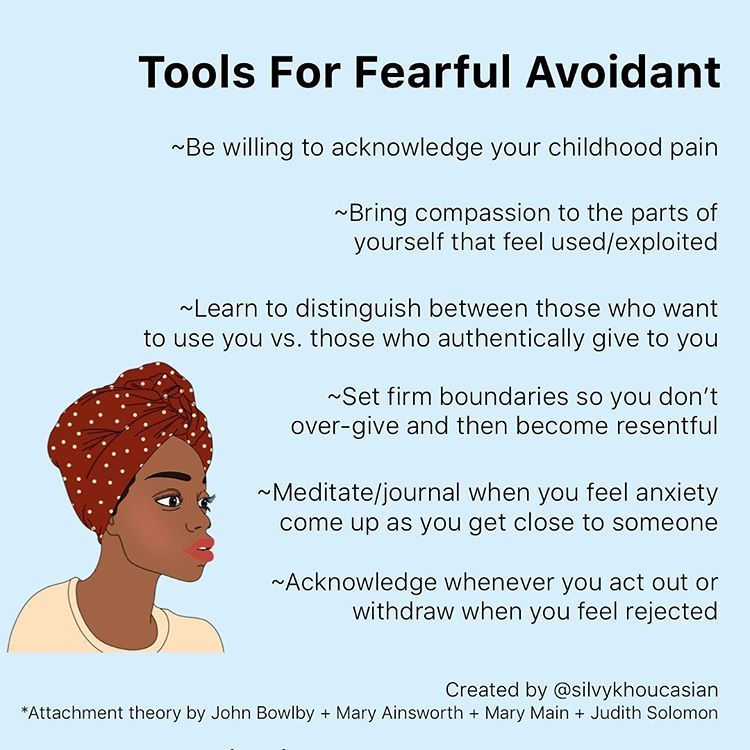 They experience frequent, intense anxiety and strong emotion in response to ups and downs in their romantic life. Constantly foreseeing problems, the sympathetic nervous system is dominant. The physical health consequences of this can be dire. Exhaustion and burnout are looming threats
They experience frequent, intense anxiety and strong emotion in response to ups and downs in their romantic life. Constantly foreseeing problems, the sympathetic nervous system is dominant. The physical health consequences of this can be dire. Exhaustion and burnout are looming threats - Jealousy: the anxiously attached person is also prone to jealousy. Constantly on the lookout for a threat, they can be preoccupied with thoughts of being cheated on. Jealous women in particular can suffer a great deal. Societal pressures make women feel like they need to be ever youthful and beautiful. More vulnerable women can be driven to distraction by the idea that their partner is spending time around younger, prettier women. False accusations may fly around left, right and center. Life is not fun for either person in the relationship.
This is why healing anxious attachment is so important if you want to have a happy life and a successful relationship.
When you are dating an anxiously attached personSo, we can see it isn’t easy to have an anxious attachment style.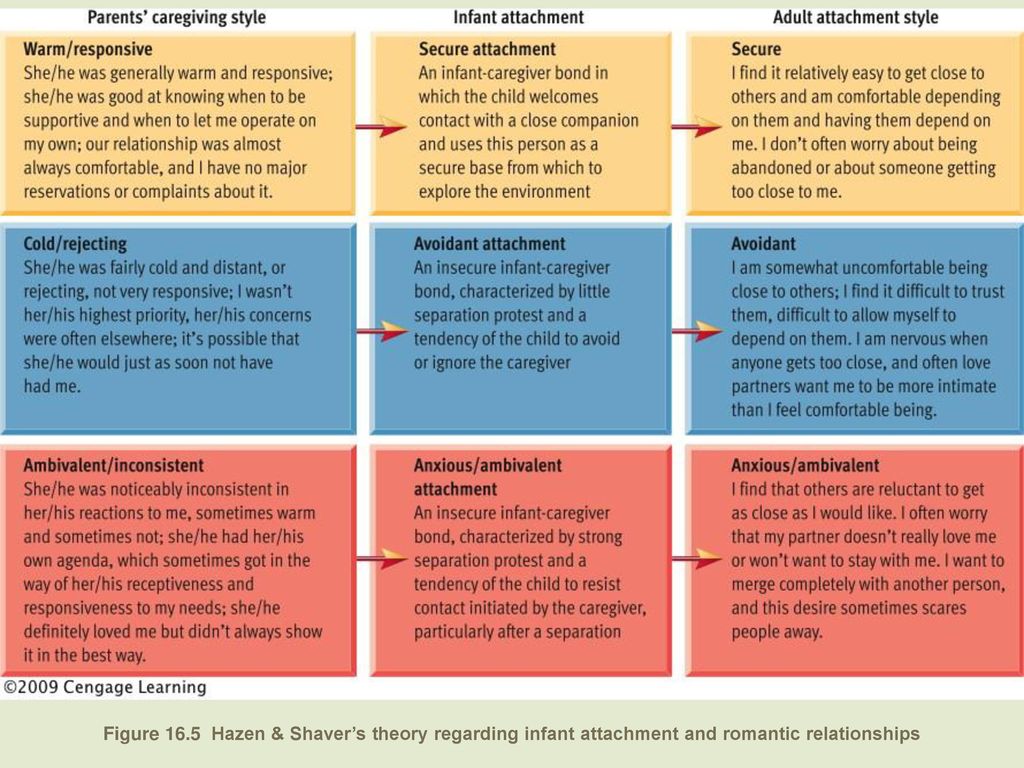 But nor is it easy to date someone with this attachment disorder.
But nor is it easy to date someone with this attachment disorder.
We have seen how behaviors of the anxious might cause problems for an avoidant partner. But even for someone with a healthy attachment style, some of their behaviors can still be quite troubling.
The constant need for reassurance and confirmation that they are loved can be annoying. Feeling responsible for your partner’s happiness is a heavy burden to carry. Having an anxiously attached partner can feel draining. They need a great deal of attention, and when they become triggered and upset, you need to know just how to handle it. If you don’t, they can be even more distressed. Many relationships fail due to the overly needy, anxiously attached individual.
Healing anxious attachment: 5 steps to move towards relationship securitySo, you think you’re anxious, or perhaps you are dating one. What next?! Well, I hope that you primarily feel some relief, because you have realized that you are neither crazy nor alone.
Attachment styles are not death sentences. They can be healed and moved through. All it takes is some retuning of the subconscious mind. By reprogramming our subconscious mind, we are effectively freeing ourselves of the programming installed during our early childhood years.
Healing anxious attachment is done by moving towards a more secure attachment style. Here are 5 simple steps you can take to start feeling more attachment security, today:
1. Develop your sense of selfThe first step to healing anxious attachment is developing your sense of self. One of the biggest voids in an anxious person’s life is their sense of self.
You are hyper aware of other people. And that is a beautiful thing – a gift in itself. But this often leads to ignoring yourself and a weak self-identity.
If you want to depend less on others, you first need to fix the relationship with YOU.
Get to know yourself. Find out what you stand for and what you enjoy doing.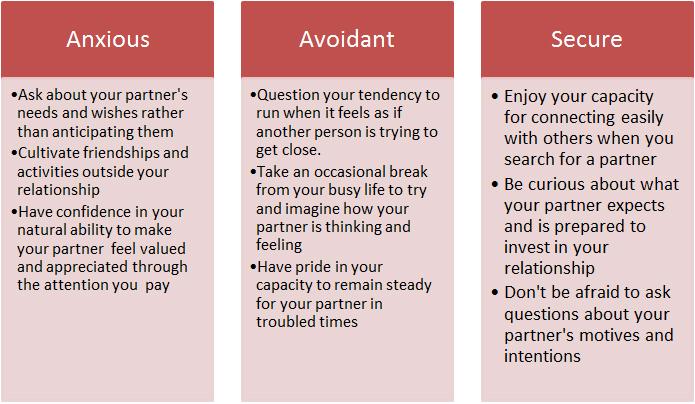 This will contribute to better self-esteem and a more robust emotional system. Rejection, or the threat of it, will bother you less when you know who you are.
This will contribute to better self-esteem and a more robust emotional system. Rejection, or the threat of it, will bother you less when you know who you are.
One of the biggest voids in the anxious person’s life is a sense of self. Due to their tendency to cling to others to gain validation, they
2. Learn to meet your own emotional needsAnother anxious attachment pattern is an over-reliance on others to get emotional needs met.
If you identify as anxious, you probably turn to your romantic partner to satisfy the majority of your emotional needs. As a child, your parents satisfied your needs for comfort, play and love for some of the time. But at other times, they were not present and your needs were left unmet.
The abandonment woundThis means that you did not learn to meet your own needs, as the avoidant partner does. But instead, developed an intense fear of not having them met by others. In adulthood, this manifests as a fear of abandonment.
In order to heal from fear of abandonment and over-reliance on others, you must learn to meet your own needs and self-soothe.
This feeds directly into step 1, because it involves the relationship with yourself. You must begin to believe and teach your subconscious mind that you can fully nurture, care for and stand up for yourself.
We develop anxious attachment as a response to inconsistency during childhood. When we were babies, our survival depended upon our parents meeting our needs. If this was not done consistently, we take this fear about survival into adulthood. When our romantic connection feels threatened in the smallest of ways, we can quite literally feel as though we are about to die.
Once you become more able to meet your own emotional needs, our survival will no longer feel threatened. Thus, the anxiety will greatly decrease.
ACTIVATE YOUR MASCULINE POWER 5-DAY COURSE
Unleash the secrets of your inner fire of willpower, harness your sacred sexual energy, and embody healthy masculine energy.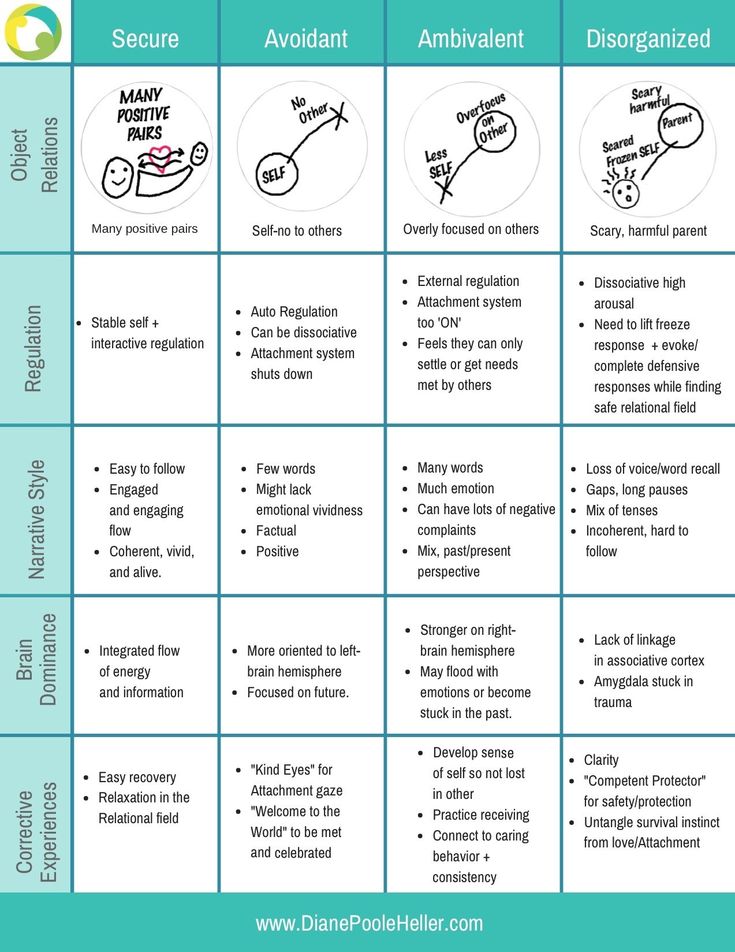
A lot of the time, the reactions of a person with anxious attachment are not incongruence with what is happening in reality.
Understanding the extent of your hypersensitivity is absolutely key to healing anxious attachment. You must identify the areas in your life where your anxiety is being triggered, and then rationalize your way through those events.
If you can master the art of overriding your natural reactions through ration, you will conquer your emotions.
If your partner says or does something that makes you feel highly distressed, step outside of the situation. Observe the facts and identify the real problem: your attachment style having been activated.
A real-life example of choosing ration over emotionFor example: your partner told you they would be home at work by 6pm. It gets to 7pm, then 8pm. They are still not home. They have not picked up any of your calls.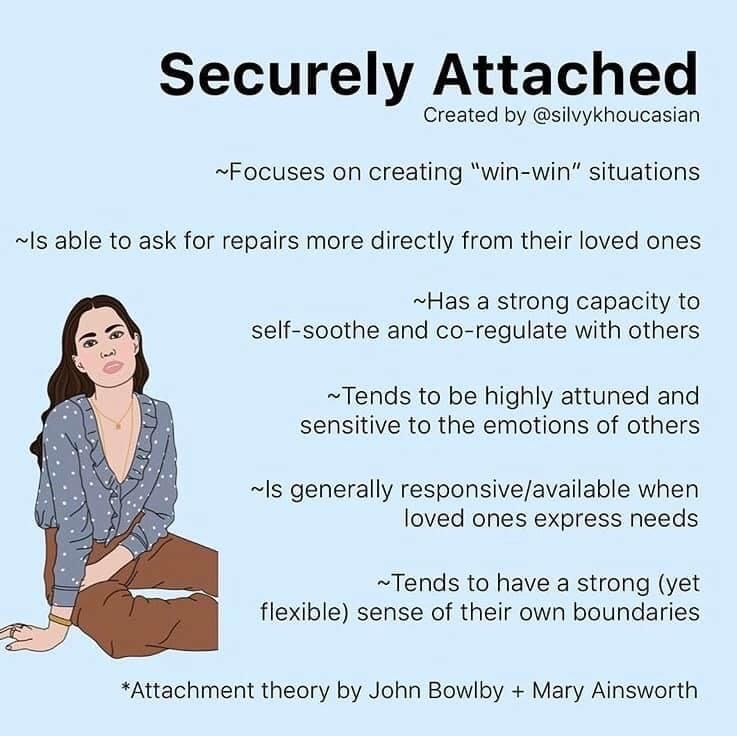
Your natural reaction might be to assume that they are going behind your back with another woman. You may start to feel extremely agitated, anxious and feel butterflies in your chest. You might be tempted to start calling them again and again to find out where they are.
It is at this point that you need to stop catastrophizing. Take note of the facts vs the fiction (which is rapidly gaining traction inside of your head). Listen to the voice of ration, which tells you that your partner might have been caught late in an extended business meeting, or countless other viable explanations.
Your activated attachment wound is screaming at you that you are about to be left. But it’s your choice whether you listen to it or not. I suggest taking the more conscious path. Most of the anxious people on the planet are walking around worrying themselves sick about things that will never happen. It is no different for people with anxious attachment. And it is a shame that something that is meant to bring so much joy and happiness – brings so much suffering and upset.
If you are anxiously attached, you may well have a problem with asking for what you need.
Due to the constant fear of being left, you fear that if you voice your needs, you will be rejected.
You may also believe that you should not need to ask your partner to meet your needs. If they love and care for you, they should be able to meet them without you asking.
Both of the above are a recipe for disaster. People have vasty differing needs. So how could someone be expected to psychically predict what another person wants?
Not voicing your needs inevitably leads to them not being met. This further perpetuates the anxious person’s feelings of inadequacy. They believe they are not worthy of having their needs met. Self-esteem remains low. And so the cycle continues.
If you have an anxious attachment style. Practice asking for the things you want, and speaking out against the things you don’t want.
5. Stop people pleasing
Stop people pleasingPeople pleasing is the toxic human habit of being a yes person. This kind of person sometimes views themselves as a martyr, and always subjugates their own desires to satisfy the desires of others.
People with an anxious attachment style have a desperate need for approval of others. This almost always leads them to become people pleasers. But people pleasers don’t tend to actually get what they most want from others (approval and respect). It actually has the opposite effect, and people lose respect for them.
This even further perpetuates the feelings of inadequacy, and leads to even more people pleasing. As you can see. It’s a viscious cycle!
If you want to move towards a secure attachment style, practice putting up some boundaries and saying no. This will also feed into a stronger sense of self, and better self-esteem. Stop taking responsibility for other people’s thoughts, feelings and emotions. Rarely are things personal.
Healing anxious attachment: your responsibilitySo, we have understood the basics of attachment theory.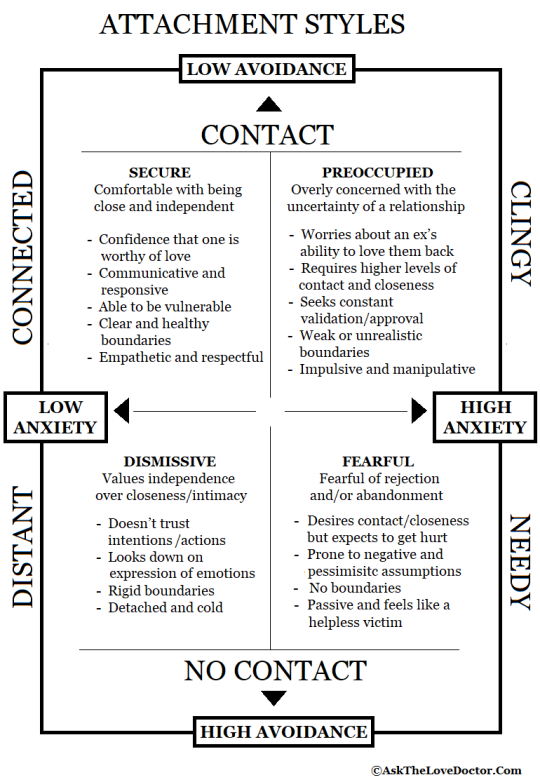 We have seen how our entire adult attachment style comes from programming installed during our earliest years. Our relationship with our parents forms the basis of our adult relationships. When we had a healthy attachment to our parents – all is good! But when we did not – we grow up with dysfunctional relationship habits and attitudes. In the case of those of us with anxious attachment, relationships can be very worrisome.
We have seen how our entire adult attachment style comes from programming installed during our earliest years. Our relationship with our parents forms the basis of our adult relationships. When we had a healthy attachment to our parents – all is good! But when we did not – we grow up with dysfunctional relationship habits and attitudes. In the case of those of us with anxious attachment, relationships can be very worrisome.
Hopefully you can now identify if you are somewhere on the anxious attachment scale. If you are, I sincerely hope you have realised how NOT alone in this you are. Although an anxious attachment style can lead to a difficult, troubled relationship, it doesn’t have to.
Anxious attachment is common. More than 25% of people on the planet have this attachment style. Although it can cause a great deal of distress, pain, shame and suffering, it can be completely healed. But doing so is your responsibility. It takes effort and time to decondition yourself. But the rewards are worth it.
If you want to start healing, the five steps above are a great place to start. They will definitely help to recondition your subconscious beliefs about love and relationships. To go even deeper into this work and truly heal an anxious attachment style, along with many other elements of life, work and relationships, you can take my free relationship training for men here.
If you are a woman reading this because you have an anxious attachment style, and your partner is avoidant, why not suggest he takes it? Regardless of where he falls on the anxious-secure-avoidant spectrum, it will help him to become a better partner, meet your needs and respond to your emotions in appropriate way.
FAQs
What helps with anxious preoccupied attachment?Learning to recognize when your attachment wound is being emotionally triggered helped a great deal with anxious attachment.
What does it mean to have an anxious attachment style?Having an anxious attachment style means that you grew up with loving yet inconsistent parents.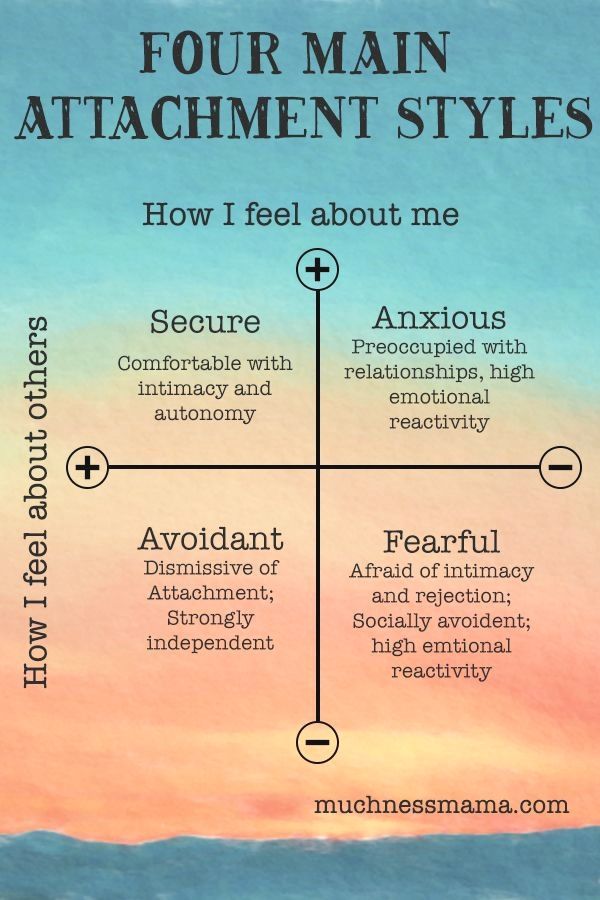 Your needs were met, but not always. Perhaps your parents worked a lot or had other children to tend to. This led you to crave intimacy, yet at the same time remain deeply fearful of losing it.
Your needs were met, but not always. Perhaps your parents worked a lot or had other children to tend to. This led you to crave intimacy, yet at the same time remain deeply fearful of losing it.
When you have anxious attachment, self-regulating can be difficult. The key is to become more emotionally intelligent. Recognize when your attachment style is activated and causing you to become disregulated. Apply ration to every situation. Trust this over your first emotional reaction.
How can you overcome an anxious attachment style?You can overcome an anxious attachment style by holding better boundaries and developing your sense of self. People pleasing behavior should also be kicked to the curb. All of these things will help to boost your self-esteem and independence. These are crucial when building a healthy attachment style.
How do people with anxious attachment feel?People with anxious attachment can struggle in their relationships, friendships and work.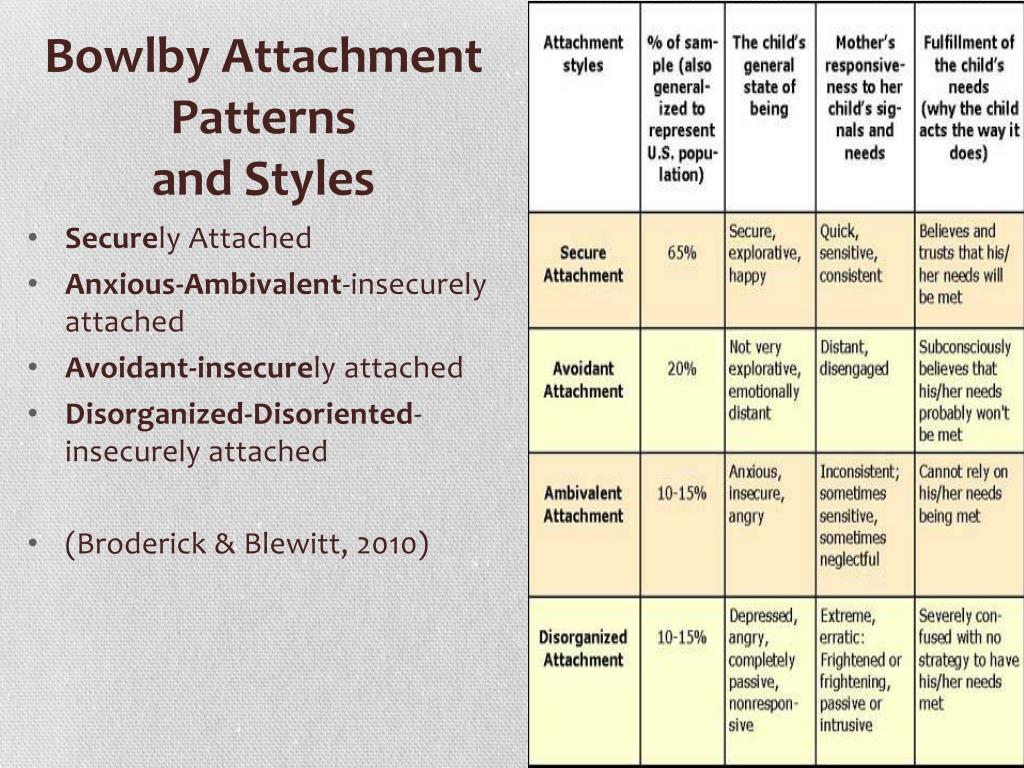 The fear of loss haunts them. They may be hypersensitive to the emotions and reactions of others. Perceiving threats between the lines, they crave intimacy yet fear losing it.
The fear of loss haunts them. They may be hypersensitive to the emotions and reactions of others. Perceiving threats between the lines, they crave intimacy yet fear losing it.
Securely attached people still get triggered. But that trigger may not cut them as deeply as it cuts someone with anxious attachment. They are less likely to suffer from mental health problems related to their relationships. Less disturbed, they can go on with their daily activities, and do not experience extreme physical symptoms of anxiety such as shaking or palpitations.
Can people with anxious attachment style have healthy relationships?Yes, people with anxious attachment style can have healthy relationships. They can lessen the degree of their relationship anxiety and move towards a more secure attachment style. If they are with an avoidant partner, however, this is more difficult. Anxious/avoidant partners tend to trigger each other. For this reason, it is better for someone who is anxious to try and find a secure partner.
Anxious/avoidant partners tend to trigger each other. For this reason, it is better for someone who is anxious to try and find a secure partner.
Dating someone with an anxious attachment style is not always easy. It can be frustrating to constantly be asked for reassurance. Observing people-pleasing behavior is also challenging and can lead to a lack of respect for one’s partner.
ACTIVATE YOUR MASCULINE POWER 5-DAY COURSE
Unleash the secrets of your inner fire of willpower, harness your sacred sexual energy, and embody healthy masculine energy.
Men's Relationship Coach
Steffo is the founder of The Tantric Man Experience, the #1 masculine mentorship program in the world. There he helps men in relationships reignite the passion to restore their marriages from the brink of divorce. And single men attract their dream women naturally with success. He's on a mission to guide men towards an intimate and meaningful relationship, and end the war with their sexuality, so they can finally become integrated men, fathers, brothers, husbands, and leaders in the world.
“It meant a paradigm shift in life.” – Patrik, Sweden
“Life-changing experience.” – Antonio, Italy
How To Self-Soothe and Heal Anxious Attachment
Anxious attachment can be painful–fear of rejection and loss, constant worry about your partner’s emotions, and low self-esteem. However, while attachment is about our relationships, it is absolutely possible to learn how to self-soothe anxious attachment. Read on for tips from a therapist.
What is anxious attachment?
Anxious attachment is one of four attachment styles first identified by psychologist Mary Ainsworth. Our understanding of attachment styles comes from what psychologists call attachment theory. Here are the key points of attachment theory you need to know to understand how to self soothe anxious attachment:
- Humans are biologically hardwired to connect with our caregivers, because doing so is necessary for us to survive infancy.
- These early relationships to our caregivers act like a roadmap for how we interact with people we love later in life, including our romantic partners.
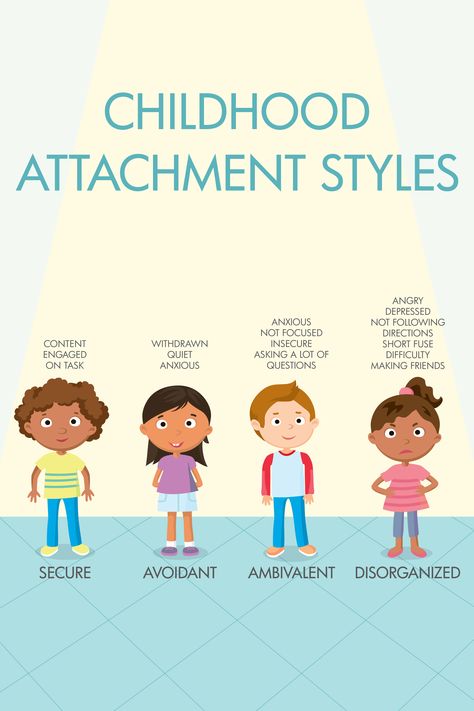
- The kind of care we receive from our grown-ups as young children informs our understanding of the world: either as a fundamentally safe and secure place where you can trust people to care for you, or as an unsafe place where you need to work hard to get your needs met. This is where we get the idea of the secure attachment style vs. insecure attachment styles (anxious, avoidant, or fearful-avoidant).
- Our attachment style is formed throughout childhood as we learn which behaviors and types of communication are most effective at getting the attention of our caregivers so that we can access the things we need, like connection, food, water, and more.
- Even if your early experiences produced an insecure attachment style (anxious, avoidant, fearful-avoidant), it is possible to learn how to experience secure attachment and enjoy healthier, happier relationships.
To learn more about attachment theory and find out your attachment style, click here.
How to self-soothe anxious attachment
Experiencing anxious attachment can be painful, but there are many ways to help yourself build a more secure attachment style. When I work with clients on their anxious attachment, we’re often thinking together about how we can help them feel more calm, happy, and secure in their partnerships.
Therefore, this first and most important step in learning to self soothe anxious attachment is to build the skills we need to ride out the most painful moments when our anxious attachment flairs up–like when you’re in conflict with your partner, wondering if the person you’re dating will text back, or wondering if your partner is angry with you. This is our in-the-moment work of “distress tolerance.”
Another thing, part of learning to self-soothe anxious attachment is to re-train our nervous system to learn that distance from our partners or uncertainty in our relationships won’t actually kill us (even if it feels like that sometimes.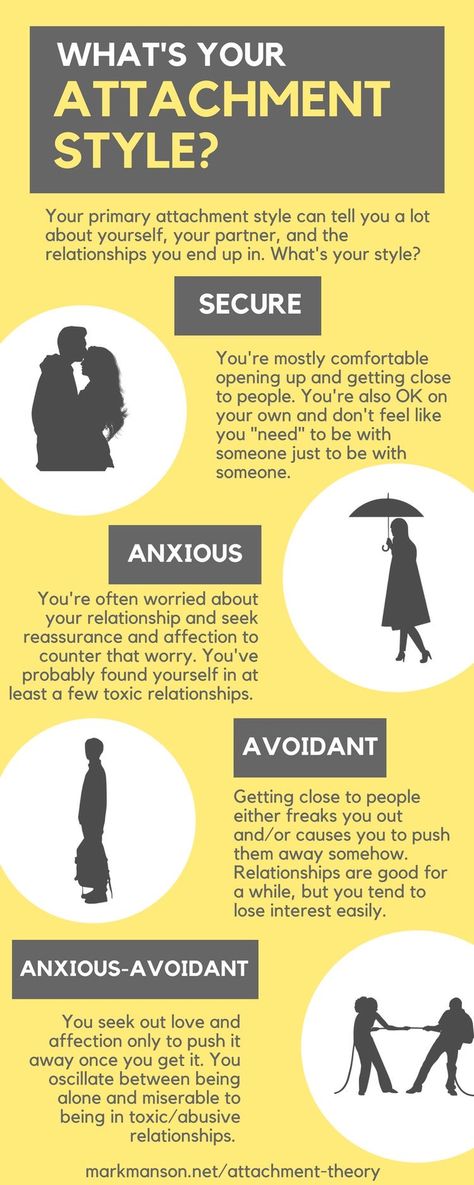 ) That means that we have to allow these painful feelings to be with us, while we practice calming our nervous system without seeking reassurance from our partner. Over time, it becomes easier to trust that these feelings won’t stay forever, and that we can trust ourselves.
) That means that we have to allow these painful feelings to be with us, while we practice calming our nervous system without seeking reassurance from our partner. Over time, it becomes easier to trust that these feelings won’t stay forever, and that we can trust ourselves.
Ideas to heal anxious attachment
When we are overwhelmed by an anxious attachment flair up it can be difficult to know what will help us feel better. That’s why I recommend clients create a list of options to help re-regulate their nervous systems ahead of time! Be sure that your list involves a few different kinds of options, including tools to…
- Calm your nervous system
- Distract yourself from the situation at hand
- Process your feelings and challenge unhelpful thoughts
- Ideas to help you calm down:
- Practice a progressive muscle relaxation exercise
- Take a walk
- Do jumping jacks for 30 seconds
- Take 10 slow, deep breaths
- Give yourself a butterfly hug
- Hug a pet
- Ideas to distract you from the situation at hand:
- Watch a favorite tv show
- Do a chore
- Play a video game
- Run an errand
- Go to your favorite coffee shop or bakery
- Take a walk
- Ideas to help you process your thoughts and feelings:
- Use the feelings wheel to give what you are experiencing a name
- Call a friend
- Talk yourself through the situation out loud
- If you’re imagining worst case scenarios, challenge yourself to imagine medium-case scenarios as well as the best case scenarios
- Write in your journal
- Talk with a therapist
Still feeling unsure where to start with your self soothing? Read more about how to build a self care playbook.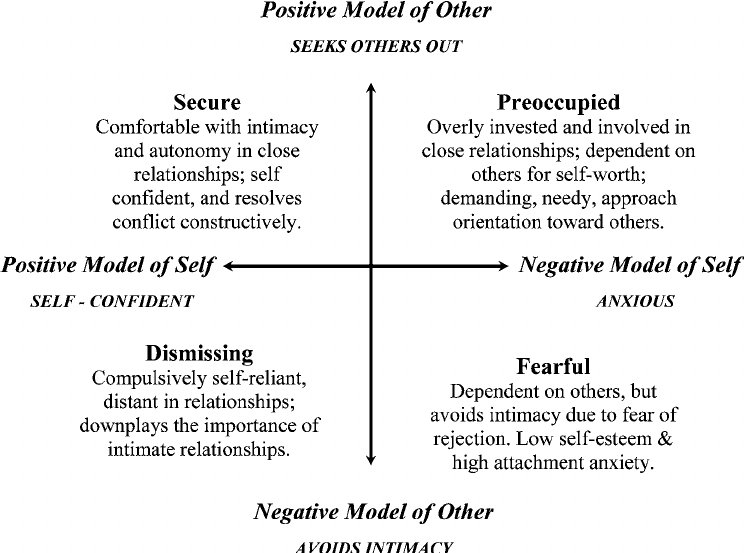
Learn to ride the waves
Navigating anxious attachment can be painful, but it also doesn’t have to last forever. With the right support in place, everyone can access more peace inside themselves and in their relationships. If you’re struggling with anxious attachment and want someone on your team to guide you through this work, reach out to one of our therapists today.
By
Kirsten Lyons, LSW
understand the types of attachment • Articles on the website of the publishing house BOMBORA
- Articles
- May 26, 2021
We talk about three types of attachment and explain what to do if your type interferes with building relationships with others.
More interesting things below
He wants to watch TV after work, but she misses him so much. She wants noisy parties, and he likes to be alone with his thoughts. And it seems like they can't be together. But it's not. It is not necessary to part with a loved one, scandal and hurt.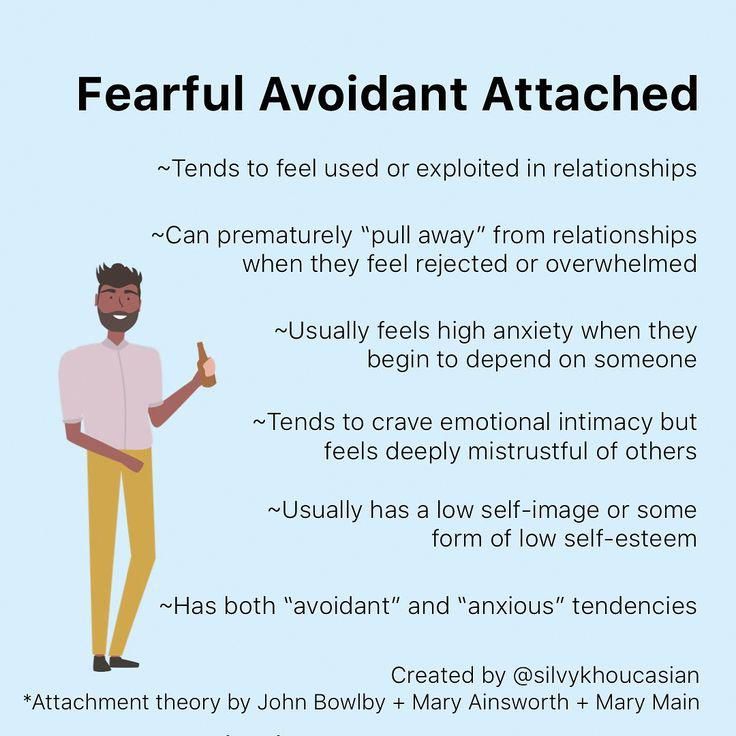 It is enough just to find out your type of attachment and build relationships. And the book of family therapist Annie Chen "Attachment Theory" will help with this. nine0010
It is enough just to find out your type of attachment and build relationships. And the book of family therapist Annie Chen "Attachment Theory" will help with this. nine0010
Anxious type
Traits of people with an anxious type:
- They are incredibly generous and considerate towards those they care about
- Fear of being rejected and abandoned
- Willingly tell others about their feelings
- Often blame others for their own feelings, eg "You make me feel so bad!".
The biggest fear of people with this type is to be alone. They do not feel safe in a relationship, fear that they will be betrayed and left alone. They really need the support and warmth of a partner. They quickly sink into despair and are disappointed in everything in advance. nine0010
An example of people with an anxious attachment type:
Asha was in her early twenties when she noticed a strange tendency in herself.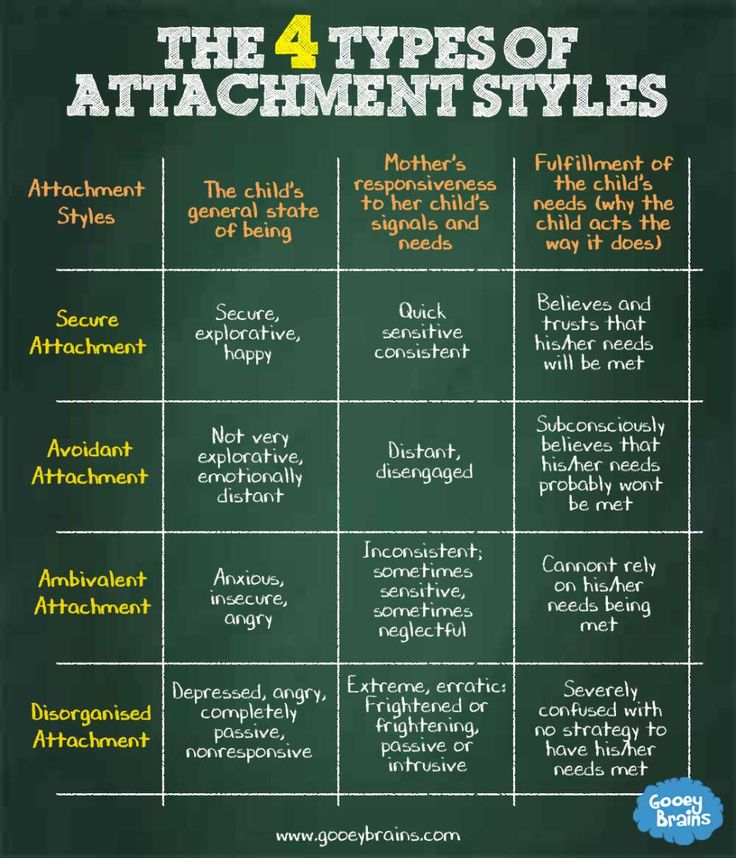 She easily approached people and made friends, but after a few years the relationship ended because of her anger and jealousy, since the interests of friends were not always connected only with her.
She easily approached people and made friends, but after a few years the relationship ended because of her anger and jealousy, since the interests of friends were not always connected only with her.
Healing the Anxious Self
If you recognize yourself in the description of the anxiety type and want to change something, here are a few steps to help you do it: nine0010
- Be patient with people
- Remember that if someone cannot meet your needs, there is nothing wrong with that.
- Learn to trust your partner and look for support within yourself
- Forgive yourself for everything you have done in the past
- Treat yourself with understanding
Avoidant
Avoidant traits:
- Self-reliant and prefer to handle problems on their own nine0004
- Do not complain or whine
- Talk about anything but themselves
- Often notice memory problems
- Avoid conflicts and negative emotions.
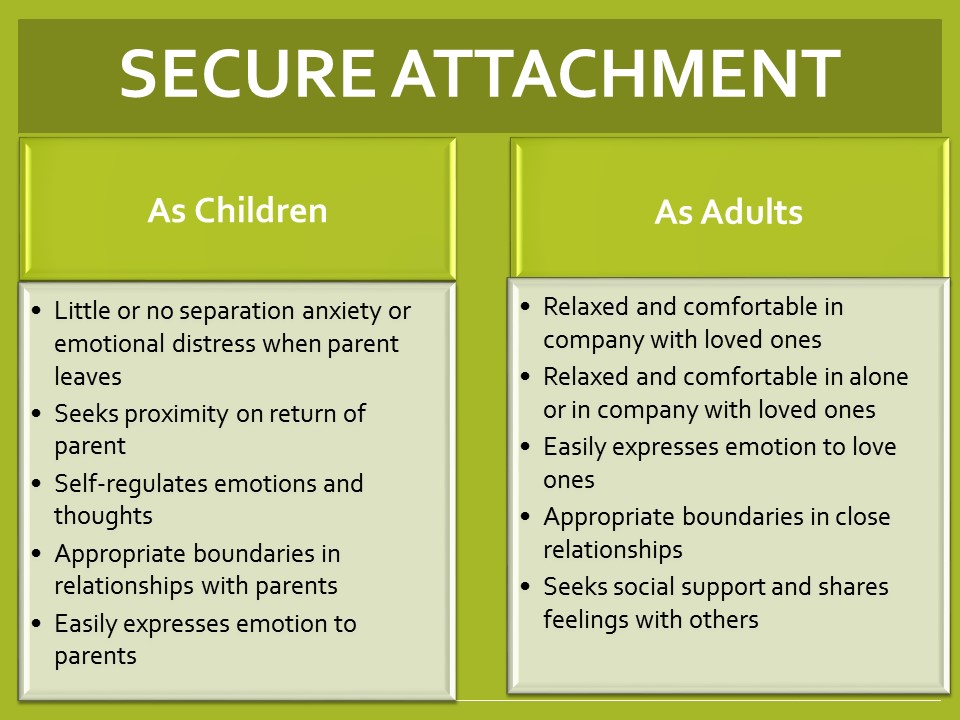
Avoidance behavior can manifest itself in various ways: through ignoring the conflict, through denial of what is happening, or even through avoidance of reality.
There are milder reactions: the desire to please others or to be needed - up to the rejection of one's needs. Reactions can be different, the main thing is that they help a person protect himself from feelings of shame and insecurity. nine0010
An example of avoidant attachments:
Kyle has been married for sixteen years. In recent years, quarrels with his wife have become much more frequent. The wife complained that Kyle does not talk about his feelings and reacts to everything with hostility. Kyle, on the other hand, wanted his wife to be happy, but did not know what was needed for this, so every time the woman raised this topic again and again, he plunged into stress.
Healing the avoidant self
If you recognize yourself in the description of an avoidant type of attachment and it has spoiled your relationship more than once, remember that this is not your fault.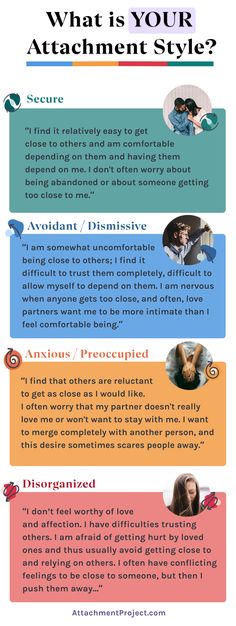 These patterns of behavior were established in childhood, before you learned to make your own decisions. nine0010
These patterns of behavior were established in childhood, before you learned to make your own decisions. nine0010
Here are some steps to help build stronger relationships:
- Accept your wants and needs
- Learn to be more open with loved ones
- Accept that everyone is different
- Learn to deal with other people if you offend them.
Reliable type
Traits of people with reliable type:
- Easily adapt to new conditions and changing circumstances nine0004
- Believe in relationships and prioritize them
- Appreciate working on relationships, especially if things go wrong
- Deal with difficulties and disagreements with confidence.
A reliable type of attachment allows a person to think clearly and adequately perceive the situation, even if a conflict arises. A person with this type does not experience stress due to closeness with other people. For people with secure attachments, connecting with others is a natural human need, a pleasant experience that they enjoy. nine0010
nine0010
An example of people with secure attachments:
Last year, Tilda faced a real set of bad luck. She was laid off at work, her mother died of cancer, and a few months later her house and her husband burned down in a terrible fire. Tilda appreciates her marriage because, going through all these difficulties, her relationship with her husband has become a source of stability for her. “It was tough for both of us, but we knew we would break through eventually. I don’t even know what I would do without him, ”Tilda shared. nine0041
It is important to remember that any type of attachment can be developed. This is not an innate, but an acquired quality.
Annie Chen's book Attachment Theory will help you build relationships with family, colleagues, and friends. In it you will find exercises, practices and tests that will allow you to better understand yourself and others and start building healthy relationships.
Buy a book.
Tell everyone what an interesting article you found!
Attachment theory.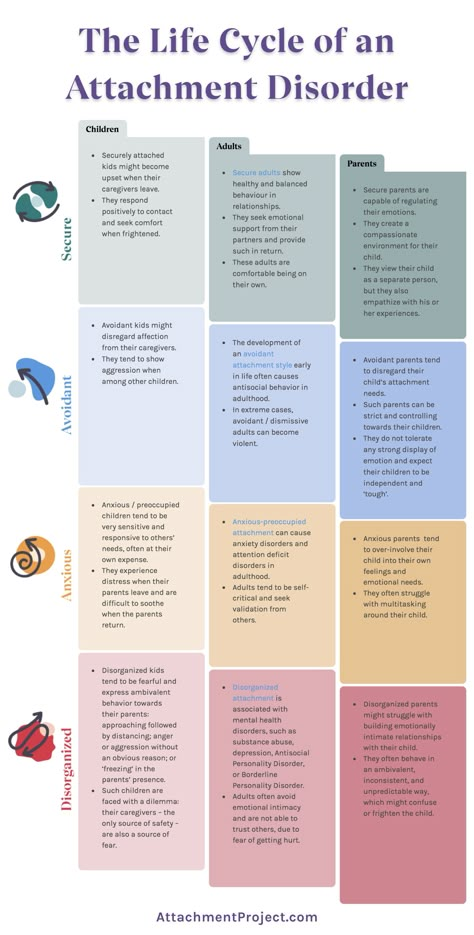 Effective Practices to Build Strong Relationships with Loved Ones and PartnerAnnie Chen
Effective Practices to Build Strong Relationships with Loved Ones and PartnerAnnie Chen
898 ₽
Buy
Read related
Interview • February 1, 2021
Is it worth giving a second chance after infidelity: advice from a psychologist
We find out why people cheat, how to survive infidelity and whether it can be avoided.
Book Reviews • December 10, 2018
The Best of Psychology: Closing the Gestalts and Discovering the Best Version of Yourself
How to stop worrying and being sad, get along with generations X, Y and Z and find your love. nine0010
How different types of attachment affect our relationships and what to do about it
April 30 Relationship
If you choose a partner from the wrong category, the union is unlikely to be strong.
We are all programmed to be attached to other people. That is why the child cries when he is separated from his mother for some time.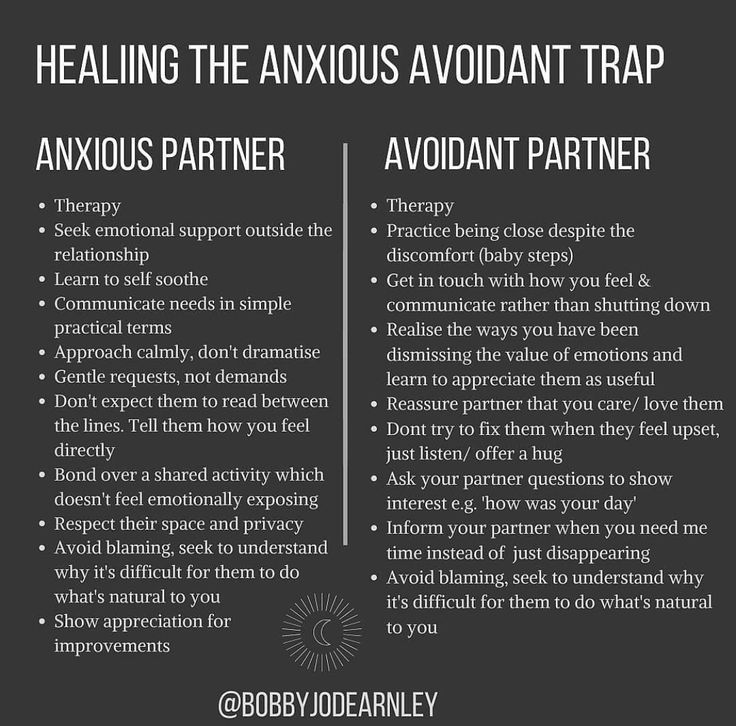 But depending on the behavior of loved ones in our childhood, personal experience and other factors, each of us forms our own type of attachment. It affects not only our relationships, but also ourselves. nine0010
But depending on the behavior of loved ones in our childhood, personal experience and other factors, each of us forms our own type of attachment. It affects not only our relationships, but also ourselves. nine0010
Types of attachment
Reliable
For people in this category, loving and caring for someone is absolutely natural. They are able to form a close bond with another person without worrying about petty misunderstandings.
"Reliable" accept partners as they are and treat them with respect. They do not play games or use manipulation, but openly talk about their successes and failures, needs and feelings. In addition, such people are attentive to the desires of a loved one and try to fulfill them. nine0010
“Reliable” people also have stable self-esteem, so they calmly perceive criticism and competently cope with conflicts. Instead of heating up the situation, they try to solve the problem, forgive a loved one or apologize.
Anxious
People with this type of attachment desire closeness and are able to maintain close contact.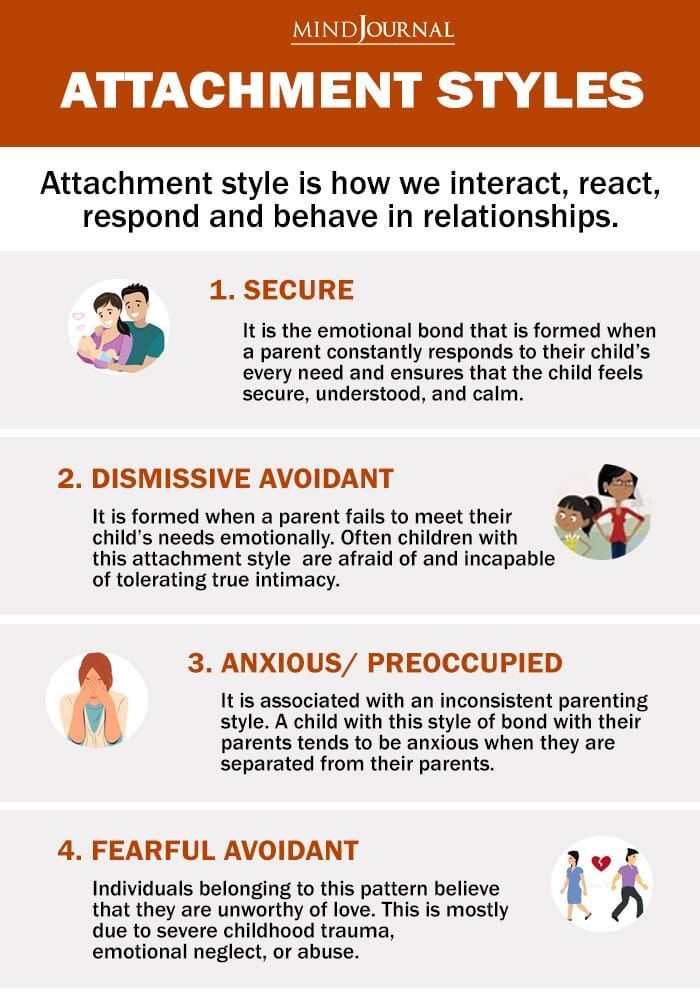 Their main problem is elsewhere. They are afraid of being abandoned, and for the sake of maintaining relationships, they forget about their own desires and needs in order to please their partner. But as a result, they feel unhappy. nine0010
Their main problem is elsewhere. They are afraid of being abandoned, and for the sake of maintaining relationships, they forget about their own desires and needs in order to please their partner. But as a result, they feel unhappy. nine0010
Anxious are fully occupied with relationships and are always "connected" to a partner. At the same time, they may worry that he wants intimacy to a lesser extent. This type takes everything to heart and gives a negative connotation to any comment of others in his address, expecting the worst.
To get rid of anxiety, such people begin to manipulate their partner. They deliberately move away to get attention and hear that they are needed. "Anxious" can react emotionally, do not answer calls, provoke a loved one to jealousy and threaten to break up. In addition, this type is quite jealous and tends to often call or write to a partner, even when he asks not to do so. nine0010
Avoidant
It includes two subtypes. The first - "disparaging" - is able to easily "cut off" difficult emotions.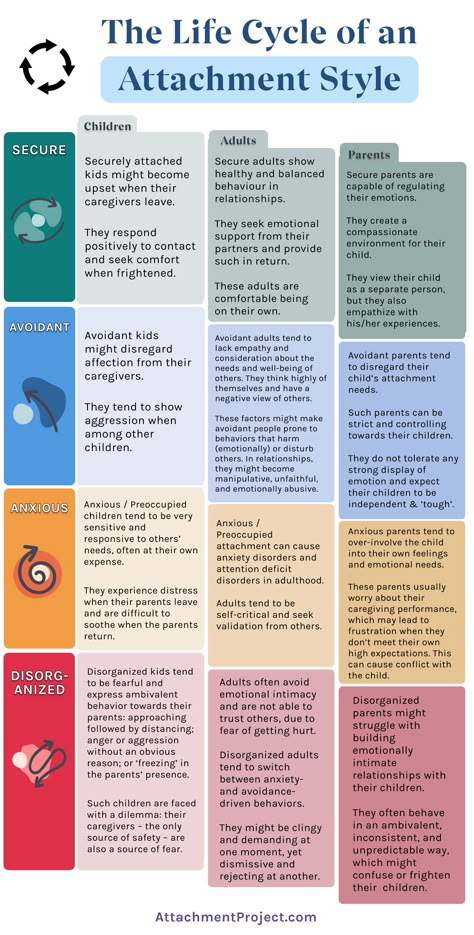 Narcissists and those who are used to suppressing their feelings fall into this category. The second - "scared" - wants close relationships, but is afraid of them and does not know how to trust.
Narcissists and those who are used to suppressing their feelings fall into this category. The second - "scared" - wants close relationships, but is afraid of them and does not know how to trust.
In general, avoidant people avoid intimacy because independence is more important to them. Of course, this does not mean that they do not like close communication at all. It's just that for them there is a certain line that should not be crossed. nine0010
In relationships they are independent, rely only on themselves and do not like to talk about their feelings. Avoiders defend their freedom and try their best to delay the moment when they have to make any commitments. And when people with this type of attachment still start a relationship, they keep their distance, notice even the smallest flaws in a partner, nostalgic for a free life or dream of an ideal union.
Avoiders react sharply to any attempts to control them or restrict their freedom. In such situations, they begin to distance themselves again: flirt with others, make rash decisions, and also ignore a loved one, his emotions and needs.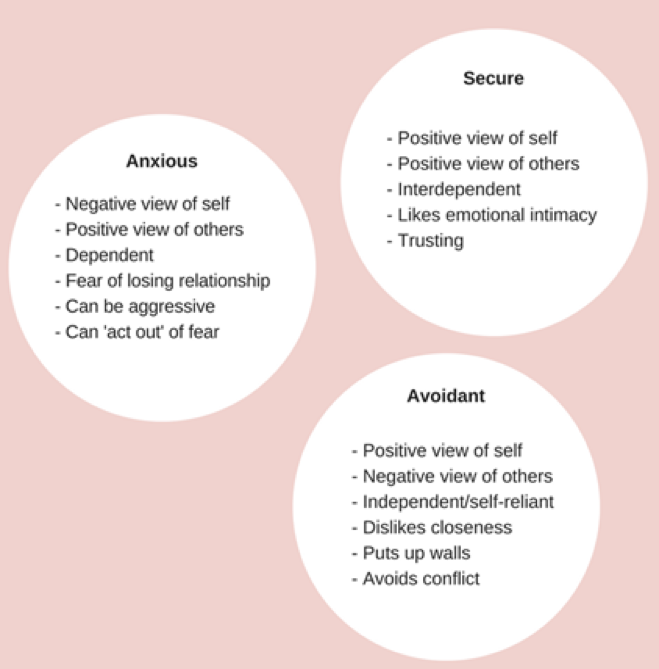 The partner may complain that they feel unwanted, and also that the "avoidant" is not open enough and does not share his secrets and experiences. nine0010
The partner may complain that they feel unwanted, and also that the "avoidant" is not open enough and does not share his secrets and experiences. nine0010
Often a person with an avoidant type of attachment considers his partner to be clingy, and against this background, he is even stronger and more independent. He doesn't worry about the end of the relationship. However, when a crack appears in a couple, the “avoiders” pretend that they do not need any connections at all and “bury” their feelings even deeper. At the same time, people with this type of attachment have the same need for intimacy as others - it is simply suppressed.
Anxiety avoidant
It is also called ambivalent or disorganized. This attachment variant combines the anxious and avoidant types, respectively, and is commonly found in survivors of abuse. Such people crave love, intimacy and care, but are afraid to enter into a relationship. They are afraid of the prospect of rejection. At the same time, they believe that they are unworthy of good things.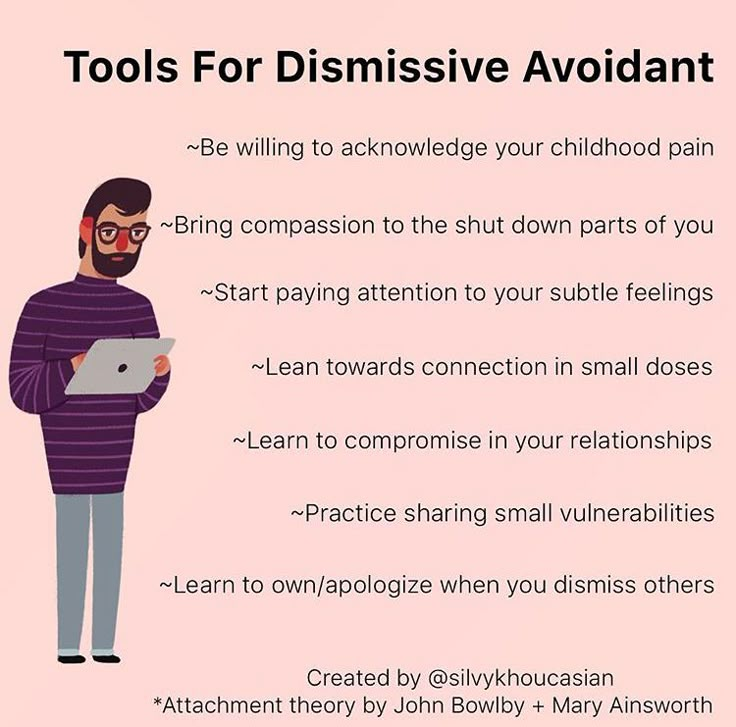
How type of attachment affects relationships
Even the most independent of us are surprised when we notice how dependent we become when we enter into a romantic relationship. This happens because an intimate relationship subconsciously stimulates our type of attachment and we begin to either trust a person or be wary of everything that happens. nine0010
To better understand how everything works in a couple, you can analyze the type of partner's attachment and start with his relationship to intimacy. Does he try to meet your needs or aggressively respond to your requests? Does he say that he is uncomfortable, or does he take a step forward and then distance himself? Self-confident people will not play games, show intractability, refuse to compromise.
Anxious and avoidant often form codependent relationships. Each of them does not understand their needs and the needs of the partner. That is why they are drawn to each other. Both types are rarely interested in "reliable" people, simply because healthy relationships are unfamiliar territory for them.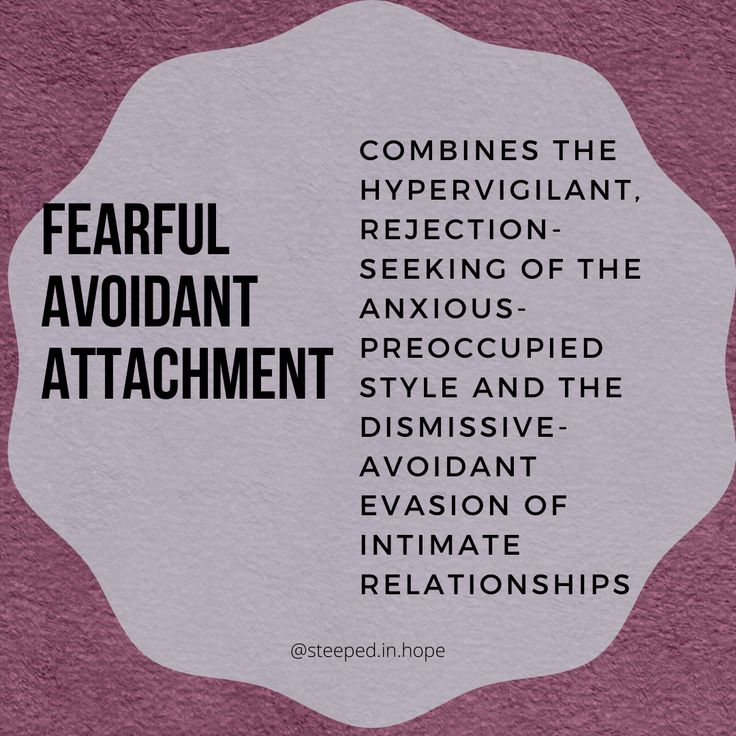 And an alliance with someone who has similar problems confirms their fears and feeds the belief that they are not good enough for love. nine0010
And an alliance with someone who has similar problems confirms their fears and feeds the belief that they are not good enough for love. nine0010
Another feature of the "anxious" is that they quickly enter into a relationship, instead of pausing and analyzing how a potential partner meets their requirements. They focus on similarities with another person, idealize the chosen one and ignore possible problems. At the same time, the “anxious” forget about their needs and do not know how to properly build communication with a partner.
This is precisely the reason why the anxious type converges with the avoidant one. When the "avoiders" begin to move away, the experiences of the "anxious" intensify. They confuse their longing and anxiety with love, not realizing that in fact the problem is not in them, but in the inaccessibility of a partner. And unfortunately, whatever they do, they can't change it. "Anxious" spend more and more energy on maintaining relationships, afraid to face the truth. And the “avoiders” need someone who will look for meetings with them. It helps them meet their emotional needs. nine0010
And the “avoiders” need someone who will look for meetings with them. It helps them meet their emotional needs. nine0010
In addition, in contrast to the reliable type, "anxious" and "avoidant" do not know how to resolve conflicts, but instead begin to defend themselves and attack the enemy. Without conflict, impulsive behavior, and "chasing" an unavailable partner, unreliable types sink into depression associated with past relationships.
How to Change Your Attachment Type
Although most of us don't change our attachment type, it can be adjusted to make us feel more comfortable. Psychotherapy or relationships with a “reliable” partner help with this. nine0010
Changing the type of attachment is also inextricably linked with overcoming codependency. This can be done in a few steps:
- Get rid of the feeling of shame and work on self-esteem. This will allow you not to take everything to heart.
- Start expressing your opinion more assertively.

- Learn to notice, respect and express your emotional needs.
- Be honest - stop playing games and manipulating others.
- Practice acceptance of yourself and others. nine0004
- Stop overreacting to little things. It is difficult, but possible, if you identify the main triggers and find out the mechanism for their appearance.
- Take care of yourself.
- Practice conflict resolution and compromise.
Anxious people need to take responsibility for themselves and learn to take their time at the initial stage of a relationship. And for the “avoidant” - take responsibility for a partner, deal with their weaknesses, learn to respect and accept their need for love, and build boundaries. nine0010
This is especially true for "anxious" and "avoidant" who have recently come out of a codependent relationship. With this development of events, both types may think that if they open again, they will find themselves in an even more dependent position.